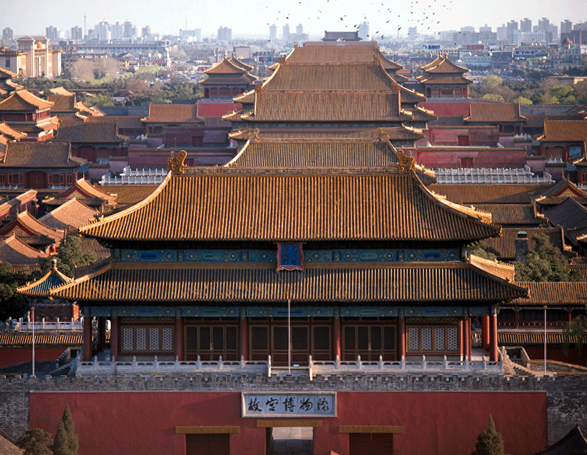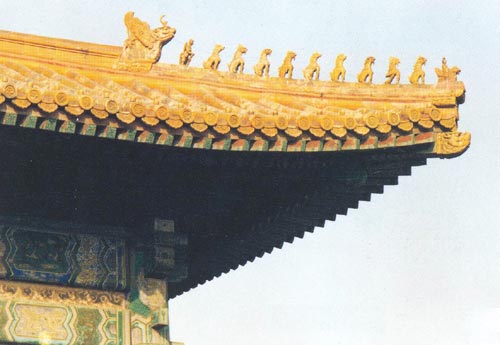| Tools: Save | Print | E-mail | Most Read |
| Numbers Inside the Forbidden City |
| Adjust font size: |
Like the sanctuaries and pyramids in ancient Egypt, the Forbidden City in Beijing has a set of rules governing the choice of its architectural dimensions. Measurements show the layout of individual courtyards in the Forbidden City was designed according to specific ratio.
The rear courtyard is 218 meters long and 118 meters wide, and the front courtyard is 437 meters long and 234 meters wide. As a result, the ratios of the length to the width in both courtyards turned out to be the same, reaching six to 11, and the courtyard in the front is twice as long and wide as the rear courtyard, which means the front courtyard is four times the size of the rear one. The Hall of Supreme Harmony was designed according to a nine-by-five standard, displaying overwhelming imperial power. There are nine bays (rooms that are each marked by 4 poles) in length and five bays in width. The ratio of its length and width is nine to five. Both nine and five carried special meanings in ancient Chinese architecture. Numbers can be divided into odds and evens, which fall into the categories of Yang and Yin respectively, the Chinese principle of opposing elements. Within the odds less than ten, nine is the highest one and five ranks in the middle. Accordingly, both nine and five connoted the supreme imperial power in ancient China. However, there are some exceptions. Tourists may find that there are 11 instead of nine bays in length in today's Hall of Supreme Harmony. The reason lies in the fact that the original Hall of Supreme Harmony was destroyed by the end of Ming Dynasty (1368-1644) and repaired in 1669 under the reign of the Emperor Kangxi in the Qing Dynasty (1644-1911). Due to the lack of a specific special superior wood during the restoration, the width was adjusted to 11 bays.
The number of zoomorphic figures engraved in the ridges of the imperial palaces was usually nine. The ridges of the Hall of Supreme Peace, however, are embossed with 10. This is the only exception to the number of zoomorphic figure in all the buildings in China - showing the uniqueness of the building. Another riddle was the number of doornails. It was an established rule to have 81 nails on every door in the imperial palace. There are usually nine rows and nine nails in every row. However, on the Donghua Gate of the Forbidden City, there were only eight rows. This is because coffins go through this gate hence the number of doornails was reduced to an even or yin number. The Golden Section, referred to as the Divine Proportion, has similarities to the architecture of the Greek Parthenon and the Renaissance architecture in Florence. But it also appears that the design and construction of the Forbidden City comply with the Golden Section Rule. The courtyard where the Gate of Supreme Harmony lies in is 200 meters long and 130 meters wide, with a ratio of width to length reaching 0.65. This number is somewhere near 0.618, the Golden Section Ratio. Also, with the distance from the Daming Gate to the Jing Mountain reaching 2.5 km, and the distance from the Daming Gate to the center of the Hall of Supreme Harmony hitting 1.5045 km, the ratio of 1.5045 to 2.5 amounts to 0.618, which is exactly the Golden Section Ratio. There is no clear proof that the design of Chinese palaces was influenced by Western architectural ideas however the employment of the Golden Section Rule in both China and the West testifies to its usefulness , and also reveals that human beings, regardless of nationality, share a common goal in the pursuit of beauty. Are there 9999.5 rooms in the Forbidden City? According to an old legend there are 9999.5 rooms in the Forbidden City, but that is not really the case. Based on the field surveys from historic building experts there are 8,707 rooms in the Forbidden City including all the palaces, halls, studios and pavilions.
Are dragons in Hall of Supreme Peace too many to count? Different kinds of dragon ornaments in the Hall of Supreme Peace can be found everywhere. People say there are too many to count. . However, after a lot of hard work, experts figured there were 13,844 altogether.
The famous Yunlong Stone Strip paved on the Imperial Palace road in the Forbidden City is the biggest carved stone in China. Records show it was carved from a 300-ton rough stone, weighing 239 tons after roughhewing and 200 after intensive carving.
How many copper jars are there in the Forbidden City? Historical records show that once there were 308 copper jars in the Forbidden City including 22 gold-plated ones. (China Daily July 20, 2007) |
| Tools: Save | Print | E-mail | Most Read |
 |
| Related Stories |



